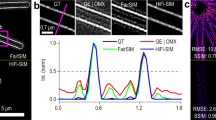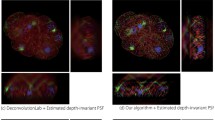Abstract
Point spread function (PSF) engineering-based methods to enhance resolution and contrast of optical microscopes have experienced great achievements in the last decades. These techniques include: stimulated emission depletion (STED), time-gated STED (g-STED), ground-state depletion microscopy (GSD), difference confocal microscopy, fluorescence emission difference microscopy (FED), switching laser mode (SLAM), virtual adaptable aperture system (VAAS), etc. Each affords unique strengths in resolution, contrast, speed and expenses. We explored how PSF engineering generally could be used to break the diffraction limitation, and concluded that the common target of PSF engineering-based methods is to get a sharper PSF. According to their common or distinctive principles to reshape the PSF, we divided all these methods into three categories, nonlinear PSF engineering, linear PSF engineering, and linear-based nonlinear PSF engineering and expounded these methods in classification. Nonlinear effect and linear subtraction is the core techniques described in this paper from the perspective of PSF reconstruction. By comparison, we emphasized each method’s strengths, weaknesses and biologic applications. In the end, we promote an expectation of prospective developing trend for PSF engineering.
Similar content being viewed by others
References
Martinez-Corral M, Caballero M T, Stelzer E H K, Swoger J. Tailoring the axial shape of the point spread function using the Toraldo concept. Optics Express, 2002, 10(1): 98–103
Köhler H. On Abbe’s theory of image formation in the microscope. Journal of Modern Optics, 1981, 28(12): 1691–1701
Toomre D, Bewersdorf J. A new wave of cellular imaging. Annual Review of Cell and Developmental Biology, 2010, 26(1): 285–314
Bloembergen N. Nonlinear Optics. New York: Benjamin, 1965
Hell S W. Increasing the resolution of far-field fluorescence light microscopy by point-spread-function engineering. In: Lakowicz J R, ed. Topics in Fluorescence Spectroscopy. New York: Springer US, 2002, 361–426
Hell S W, Wichmann J. Breaking the diffraction resolution limit by stimulated emission: stimulated-emission-depletion fluorescence microscopy. Optics Letters, 1994, 19(11): 780–782
Hell S W, Kroug M. Ground-state-depletion fluorscence microscopy: a concept for breaking the diffraction resolution limit. Applied Physics B, Lasers and Optics, 1995, 60(5): 495–497
Irvine S E, Staudt T, Rittweger E, Engelhardt J, Hell S W. Direct light-driven modulation of luminescence from Mn-doped ZnSe quantum dots. Angewandte Chemie (International ed. in English), 2008, 120(14): 2725–2728
Hofmann M, Eggeling C, Jakobs S, Hell S W. Breaking the diffraction barrier in fluorescence microscopy at low light intensities by using reversibly photoswitchable proteins. Proceedings of the National Academy of Sciences of the United States of America, 2005, 102(49): 17565–17569
Bossi M, Belov V, Polyakova S, Hell S W. Reversible red fluorescent molecular switches. Angewandte Chemie (International ed. in English), 2006, 45(44): 7462–7465
Hao X, Kuang C, Li Y, Liu X. Reversible saturable optical transitions based fluorescence nanoscopy. Laser & Optoelectronic Progress, 2012, 49(3): 34–42
Sauer M. Reversible molecular photoswitches: a key technology for nanoscience and fluorescence imaging. Proceedings of the National Academy of Sciences of the United States of America, 2005, 102(27): 9433–9434
Hell S W, Dyba M, Jakobs S. Concepts for nanoscale resolution in fluorescence microscopy. Current Opinion in Neurobiology, 2004, 14(5): 599–609
Kuang C, Li S, Liu W, Hao X, Gu Z, Wang Y, Ge J, Li H, Liu X. Breaking the diffraction barrier using fluorescence emission difference microscopy. Scientific Reports, 2013, 3: 1441
Farahani J N, Schibler M J, Bentolila L A. Stimulated emission depletion (STED) microscopy: from theory to practice. Microscopy: Science, Technology, Applications and Education, 2010, 2: 1539–1547
Hewlett S J, Wilson T. Resolution enhancement in threedimensional confocal microscopy. Machine Vision and Applications, 1991, 4(4): 233–242
Heintzmann R, Sarafis V, Munroe P, Nailon J, Hanley Q S, Jovin T M. Resolution enhancement by subtraction of confocal signals taken at different pinhole sizes. Micron, 2003, 34(6-7): 293–300
Wilson T, Hamilton D K. Difference confocal scanning microscopy. Optica Acta: International Journal of Optics, 1984, 31(4): 453–465
Sheppard C J R, Cogswell C J. Confocal microscopy with detector arrays. Journal of Modern Optics, 1990, 37(2): 267–279
Dehez H, Piché M, Koninck Y D. High resolution imaging with TM01 laser beams. International Society for Optics and Photonics, 2009, 7386: 738606
Dehez H, Piché M, De Koninck Y. Resolution and contrast enhancement in laser scanning microscopy using dark beam imaging. Optics Express, 2013, 21(13): 15912–15925
Fang Y, Wang Y, Kuang C, Liu X. Enhancing the resolution and contrast in CW-STED microscopy. Optics Communications, 2014, 322: 169–174
Hao X, Kuang C, Gu Z, Li S, Ge J, Liu X. Optical super-resolution by subtraction of time-gated images. Optics Letters, 2013, 38(6): 1001–1003
Horrocks M H, Palayret M, Klenerman D, Lee S F. The changing point-spread function: single-molecule-based super-resolution imaging. Histochemistry and Cell Biology, 2014, 141(6): 577–585
Pawley J. Handbook of Biological Confocal Microscopy. Berlin: Springer, 2010
Juette M F, Gould T J, Lessard M D, Mlodzianoski M J, Nagpure B S, Bennett B T, Hess S T, Bewersdorf J. Three-dimensional sub-100 nm resolution fluorescence microscopy of thick samples. Nature Methods, 2008, 5(6): 527–529
Zahreddine R N, Cormack R H, Cogswell C J. Simultaneous quantitative depth mapping and extended depth of field for 4D microscopy through PSF engineering. International Society for Optics and Photonics, 2012, 8227: 822705
Martínez-Corral M. Point spread function engineering in confocal scanning microscopy. International Society for Optics and Photonics, 2003, 5182: 112–122
Hell S W. Toward fluorescence nanoscopy. Nature Biotechnology, 2003, 21(11): 1347–1355
Keller J. Optimal de-excitation patterns for RESOLFT-microscopy. 2006, http://www.ub.uni-heidelberg.de/archiv/7163
Ding Y, Xi P, Ren Q. Hacking the optical diffraction limit: review on recent developments of fluorescence nanoscopy. Chinese Science Bulletin, 2011, 56(18): 1857–1876
Hell SW, Jakobs S, Kastrup L. Imaging and writing at the nanoscale with focused visible light through saturable optical transitions. Applied Physics A, Materials Science & Processing, 2003, 77(7): 859–860
Vicidomini G, Schönle A, Ta H, Han K Y, Moneron G, Eggeling C, Hell S W. STED nanoscopy with time-gated detection: theoretical and experimental aspects. PLOS ONE, 2013, 8(1): e54421
Vicidomini G, Moneron G, Han K Y, Westphal V, Ta H, Reuss M, Engelhardt J, Eggeling C, Hell S W. Sharper low-power STED nanoscopy by time gating. Nature Methods, 2011, 8(7): 571–573
Wang Y, Kuang C, Gu Z, Xu Y, Li S, Hao X, Liu X. Time-gated stimulated emission depletion nanoscopy. Optical Engineering (Redondo Beach, Calif), 2013, 52(9): 093107-1–093107-8
Boyer G, Sarafis V. Two pinhole superresolution using spatial filters. Optik-International Journal for Light and Electron Optics, 2001, 112(4): 177–179
Cox I J, Sheppard C J R, Wilson T. Reappraisal of arrays of concentric annuli as superresolving filters. Journal of the Optical Society of America, 1982, 72(9): 1287–1291
Cox I J, Sheppard C J R. Information capacity and resolution in an optical system. Journal of the Optical Society of America A, 1986, 3(8): 1152–1158
Wang Y, Kuang C, Gu Z, Liu X. Image subtraction method for improving lateral resolution and SNR in confocal microscopy. Optics & Laser Technology, 2013, 48: 489–494
Okugawa H. A new imaging method for confocal microscopy. International Society for Optics and Photonics, 2008, 6860: 68600K-1–68600K-7
Gasecka A, Daradich A, Dehez H, Piché M, Côté D. Resolution and contrast enhancement in coherent anti-Stokes Raman-scattering microscopy. Optics Letters, 2013, 38(21): 4510–4513
Xue Y, Kuang C, Li S, Gu Z, Liu X. Sharper fluorescent superresolution spot generated by azimuthally polarized beam in STED microscopy. Optics Express, 2012, 20(16): 17653–17666
Li S, Kuang C, Hao X, Wang Y, Ge J, Liu X. Enhancing the performance of fluorescence emission difference microscopy using beam modulation. Journal of Optics, 2013, 15(12): 125708–125715
Hao X, Kuang C, Wang T, Liu X. Effects of polarization on the deexcitation dark focal spot in STED microscopy. Journal of Optics, 2010, 12(11): 115707
Rong Z, Li S, Kuang C, Xu Y, Liu X. Real-time super-resolution imaging by high-speed fluorescence emission difference microscopy. Journal of Modern Optics, 2014, 61(16): 1364–1371
Chmyrov A, Keller J, Grotjohann T, Ratz M, d’Este E, Jakobs S, Eggeling C, Hell S W. Nanoscopy with more than 100,000 ‘doughnuts’. Nature Methods, 2013, 10(8): 737–740
Author information
Authors and Affiliations
Corresponding author
Additional information
Yue Fang is a master student in the Department of Optical Engineering at Zhejiang University in Hangzhou, Zhejiang, China. She received the bachelor degree in Chongqing University College of Optoelectronic Engineering in 2013. Her current research interests are in optical microscopy, nanoscopy and high-precision optical measurement.
Cuifang Kuang is an associate professor in the Department of Optical Engineering at Zhejiang University in Hangzhou, Zhejiang, China. He received the Ph.D. degree in School of Science of Beijing Jiaotong University in 2007. From January of 2006 to July of 2006, he went on an academic visit to University of Michigan funded by the Scholarship for Outstanding Doctoral Students. His current research interests are in optical microscopy, nanoscopy and high-precision optical measurement. He is the coauthor of about 60 international refereed journal papers.
Ye Ma is currently studying for his B. Eng. degree in the Department of Optical Engineering at Zhejiang University in Hangzhou, Zhejiang, China. He chiefly commits himself to the research on optical super-resolution imaging technology.
Yifan Wang is a Ph.D. candidate in the Department of Optical Engineering at Zhejiang University in Hangzhou, Zhejiang, China. He received the B.S. degree in Xidian University. His current research interests include optical superresolution and digital image processing.
Xu Liu obtained his B.S. and M.S. degrees from Zhejiang University in 1984 and 1986, respectively. He had his Ph.D. degree from Ecole Nationale Superieure de Physique de Marseille in France in 1990. He has been a professor in the Department of Optical Engineering of Zhejiang University since 1995. Currently, he is the Dean of Faculty of Information Technology of Zhejiang University, the Director of the State Key Laboratory of Modern Optical Instrumentation in China. His research fields are: thin film optics and coatings techniques, 3D display, optical imaging and instrumentation. He is the author and co-author of more than 200 journal papers in the above research fields.
Rights and permissions
About this article
Cite this article
Fang, Y., Kuang, C., Ma, Y. et al. Resolution and contrast enhancements of optical microscope based on point spread function engineering. Front. Optoelectron. 8, 152–162 (2015). https://doi.org/10.1007/s12200-015-0479-x
Received:
Accepted:
Published:
Issue Date:
DOI: https://doi.org/10.1007/s12200-015-0479-x




